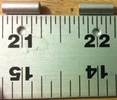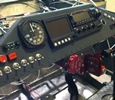


random user submitted photo
Lift Reserve Indicator
Re: Lift Reserve Indicator
jmattson wrote:Morning everyone, could someone explain the pros to having a LRI? What does it do that an airspeed indicator won't? Is there maybe a website to look at that will explain everything? Maybe a past post that I missed? Forgive me, I'm new to this particular instrument... Thanks guys!
A LRI is just another type of angle of attack instrument (mostly). The difference between what an AoA meter does and what an airspeed instrument does is significant. Aircraft fly on the wing and the wing performs in accordance with its angle of attack. A wing always stalls at the same AoA...no matter what gross weight or how many Gs its pulling. Same for best rate of climb, best glide, etc...always at the same AoA.
An ASI shows the published stall speed only in one particular condition...at a specific gross weight and at 1 G. If you are loaded heavy the stall will occur at a higher airspeed, if you are pulling Gs the stall will occur at a higher airspeed. So in effect the ASI is a lousy way to avoid stalling if you are trying to fly at the edge of the envelope.
Navy pilots fly all carrier approaches using AoA guidance only...they never use the airspeed indicator.
- radfordc
- Posts: 573
- Joined: Fri Jun 03, 2011 9:39 am
Re: Lift Reserve Indicator
Thanks radfordc, I now see why having a LRI is beneficial. I guess I'll be installing one in my own project as well! :D
Josh Mattson
Sonex #555
Springfield, Il.
Sonex #555
Springfield, Il.
- jmattson
- Posts: 24
- Joined: Sun Aug 18, 2013 11:32 pm
Re: Lift Reserve Indicator
Just to provide another perspective - and no disrespect meant to any Navy pilots or builders installing a LRI- it is not a required instrument. Glider guys fly just above stall for large percentages of time while thermalling. Sometimes S&L, sometimes in a gentle bank, sometimes at or beyond 60 degrees. You will not find them looking at the ASI either. They are looking out the window so they don't crash into their buddies. When you are towing in a glider, and they pitch the rope, you can roll a Pawnee over, pull hard to be just above stall, yet less than 2G, and come out the bottom of the split S at less than 100 because of all the induced drag. All this without looking at the ASI. When I did my acro training I confess I would check the ASI for entry speeds, but generally not for maneuvers. It is all a matter of practice. Practice for the feel and situational awareness. I am all for builders adding stuff they like. That is part of the homebuilding scene. But I also think I could do a carrier landing in my Waiex without a LRI. Of course that is probably BS!
Bryan Cotton
Poplar Grove, IL C77
Waiex 191 N191YX
Taildragger, Aerovee, acro ailerons
dual sticks with sport trainer controls
Prebuilt spars and machined angle kit
Year 2 flying and approaching 200 hours December 23
Poplar Grove, IL C77
Waiex 191 N191YX
Taildragger, Aerovee, acro ailerons
dual sticks with sport trainer controls
Prebuilt spars and machined angle kit
Year 2 flying and approaching 200 hours December 23
-

Bryan Cotton - Posts: 5120
- Joined: Mon Jul 01, 2013 9:54 pm
- Location: C77
Re: Lift Reserve Indicator
*
Last edited by daleandee on Wed Aug 23, 2017 5:54 pm, edited 1 time in total.
-

daleandee - Posts: 815
- Joined: Fri Feb 01, 2013 6:14 pm
Re: Lift Reserve Indicator
Based strictly on my flying experience, I've flown 3 aircraft that had AOA, a CRJ, Citation CJ3 and currently a Pilatus PC12. On the CRJ/CJ3 it's supplemental, but on the PC12 the AOA becomes the primary airspeed reference on landing (per the manufacturer), and for very good reasons. Now, I suppose I'm spoiled and feel naked without it. I'm installing LRI because I feel I have a better understanding of how to precisely control an aircraft in the low speed envelope with the additional information it provides. And because, compared to the other instruments I'll be installing, it's cheap and easy!
I'd say this debate could run along the same lines as the priming debate. Some people swear by it, others don't see the point.
One note on LRI vs AOA, I like to call LRI poor-pilot's AOA because while similar, it's not as accurate when it comes to accelerated stalls. You'll calibrate the LRI to be correct at approach/landing airspeed, where it will be giving you a relatively accurate representation of AOA relative to stall, but at higher airspeeds you can enter an accelerated stall with the LRI still in the green. This is because it's not a vane measuring actual AOA, it's just measuring pressure differential, and higher airspeeds means more overall pressure entering the 2 holes... I could go on but it gets technical. Point is, you get LRI for added safety information at low speeds (climbout, approach, landing.)
I'd say this debate could run along the same lines as the priming debate. Some people swear by it, others don't see the point.
One note on LRI vs AOA, I like to call LRI poor-pilot's AOA because while similar, it's not as accurate when it comes to accelerated stalls. You'll calibrate the LRI to be correct at approach/landing airspeed, where it will be giving you a relatively accurate representation of AOA relative to stall, but at higher airspeeds you can enter an accelerated stall with the LRI still in the green. This is because it's not a vane measuring actual AOA, it's just measuring pressure differential, and higher airspeeds means more overall pressure entering the 2 holes... I could go on but it gets technical. Point is, you get LRI for added safety information at low speeds (climbout, approach, landing.)
Ryan Roth
N197RR - Waiex #197 (Turbo Aerovee Taildragger)
Knoxville, TN (Hangar at KRKW)
My project blog: http://www.rynoth.com/wordpress/waiex/
Time-lapse video of my build: https://www.youtube.com/watch?v=Q8QTd2HoyAM
N197RR - Waiex #197 (Turbo Aerovee Taildragger)
Knoxville, TN (Hangar at KRKW)
My project blog: http://www.rynoth.com/wordpress/waiex/
Time-lapse video of my build: https://www.youtube.com/watch?v=Q8QTd2HoyAM
-

Rynoth - Posts: 1308
- Joined: Fri Jul 26, 2013 1:32 pm
- Location: Knoxville, TN
Re: Lift Reserve Indicator
Rynoth wrote:One note on LRI vs AOA, I like to call LRI poor-pilot's AOA because while similar, it's not as accurate when it comes to accelerated stalls. You'll calibrate the LRI to be correct at approach/landing airspeed, where it will be giving you a relatively accurate representation of AOA relative to stall, but at higher airspeeds you can enter an accelerated stall with the LRI still in the green. This is because it's not a vane measuring actual AOA, it's just measuring pressure differential, and higher airspeeds means more overall pressure entering the 2 holes... I could go on but it gets technical. Point is, you get LRI for added safety information at low speeds (climbout, approach, landing.)
Have you actually verified that the LRI isn't accurate at higher airspeeds? I was under the impression that even though the actual dynamic air pressure is higher at higher speeds the difference remains the same. And "difference" in pressure at the two ports is what the instrument measures.
- radfordc
- Posts: 573
- Joined: Fri Jun 03, 2011 9:39 am
Re: Lift Reserve Indicator
Bryan Cotton wrote:Just to provide another perspective - and no disrespect meant to any Navy pilots or builders installing a LRI- it is not a required instrument. !
I agree that it would be difficult to stall a Sonex and not be aware of it....but I'm sure someone has done it.
- radfordc
- Posts: 573
- Joined: Fri Jun 03, 2011 9:39 am
Re: Lift Reserve Indicator
radfordc wrote:Have you actually verified that the LRI isn't accurate at higher airspeeds? I was under the impression that even though the actual dynamic air pressure is higher at higher speeds the difference remains the same. And "difference" in pressure at the two ports is what the instrument measures.
I haven't verified it personally, but conceptually it makes sense and I've read about it. Basically as the air pressures rise (increasing airspeed) the differential pressure gap will also rise. From a percentage basis the differential might remain the same at all airspeeds (this may or may not be true), but the gauge measures absolute differential pressure.
What's interesting and still makes the probe useful at higher speeds is that it still gives you "Life in reserve", that is, if you do put the plane into an accelerated stall at a higher airspeed and the indicator is still in the green, it's actually telling you that you do have enough airspeed (reserve lift) to keep flying, if only you would reduce the angle of attack. In that sense it's acting as a pseudo-airspeed indicator as well.
In other words, if you lose your airspeed indicator, you could keep the LRI in the green and fly all the way home, plus use it when reducing to approach/landing speeds.
Ryan Roth
N197RR - Waiex #197 (Turbo Aerovee Taildragger)
Knoxville, TN (Hangar at KRKW)
My project blog: http://www.rynoth.com/wordpress/waiex/
Time-lapse video of my build: https://www.youtube.com/watch?v=Q8QTd2HoyAM
N197RR - Waiex #197 (Turbo Aerovee Taildragger)
Knoxville, TN (Hangar at KRKW)
My project blog: http://www.rynoth.com/wordpress/waiex/
Time-lapse video of my build: https://www.youtube.com/watch?v=Q8QTd2HoyAM
-

Rynoth - Posts: 1308
- Joined: Fri Jul 26, 2013 1:32 pm
- Location: Knoxville, TN
Re: Lift Reserve Indicator
What I like about the LRI is it supposably works the same independent of density altitude. Flying in our mountains, you can really squeeze that last bit of lift out to clear that ridge with an acceptable safety margin. Without an LRI, you could end up like so many other pilots, in the trees below.
John Gillis
SEL Private, Comm Glider, Tow pilot (Pawnee Driver)
Waiex N116YX, Jabiru 3300, Tail dragger,
First flight, 3/16/2013. 403 hours and climbing.
Home: CO15. KOSH x 5
Flying a B-Model Conversion (Super Bee Baby!)
-

fastj22 - Posts: 1594
- Joined: Sun Aug 21, 2011 5:56 pm
- Location: Mile High
Re: Lift Reserve Indicator
*
Last edited by daleandee on Wed Aug 23, 2017 5:53 pm, edited 2 times in total.
-

daleandee - Posts: 815
- Joined: Fri Feb 01, 2013 6:14 pm
Who is online
Users browsing this forum: No registered users and 19 guests







